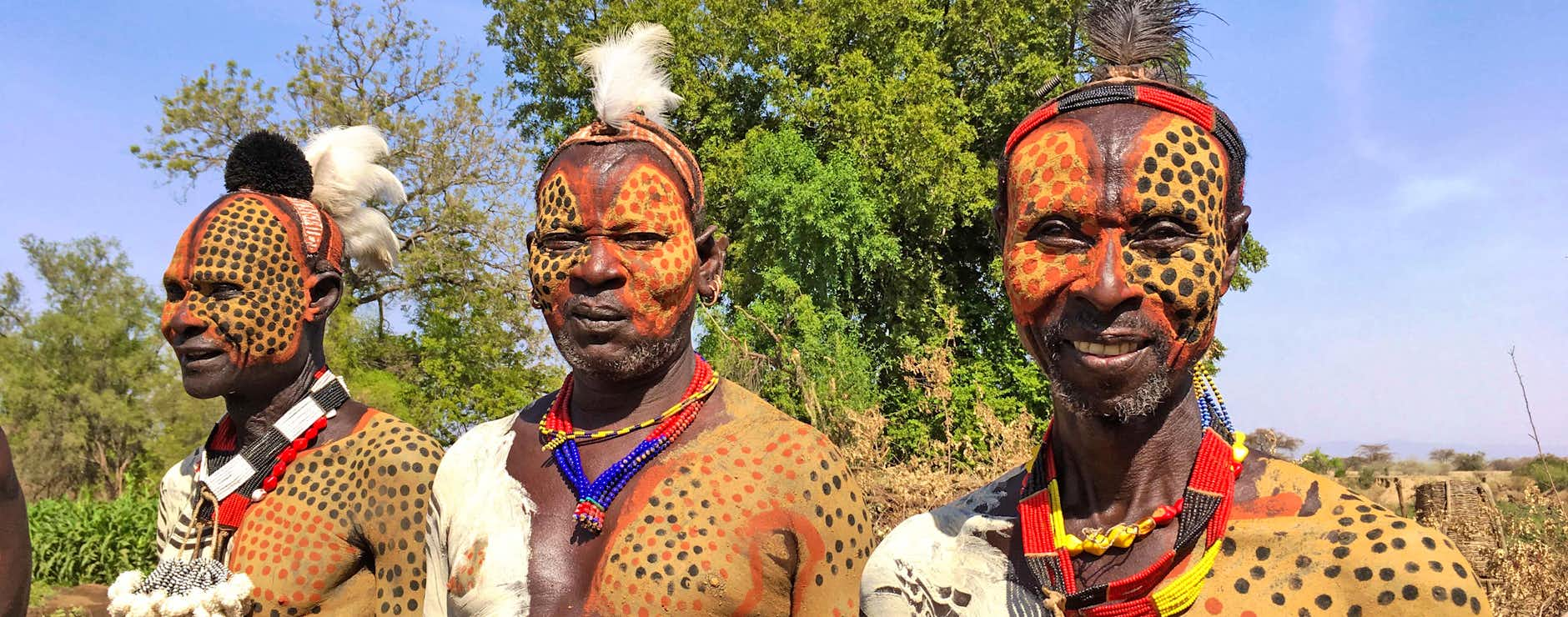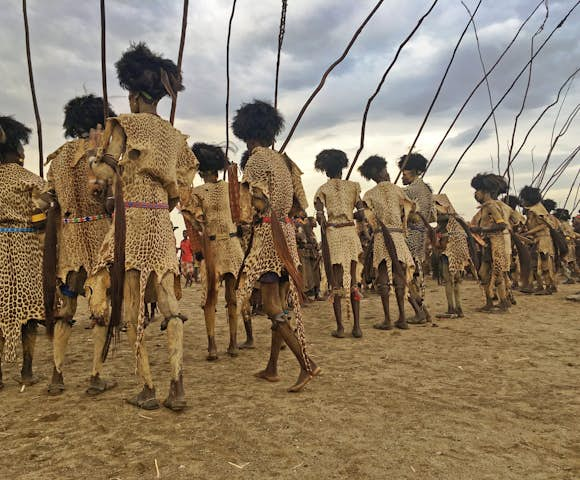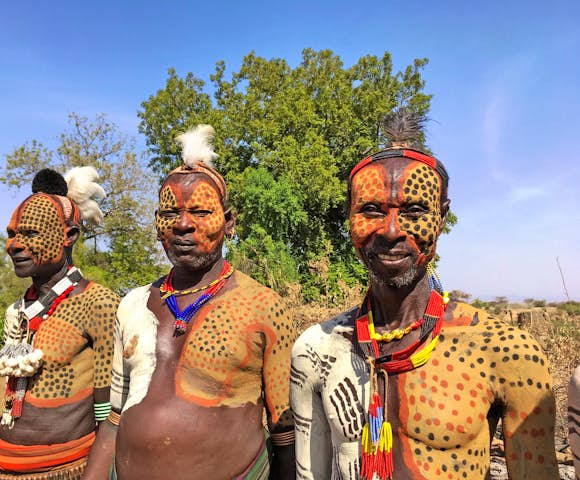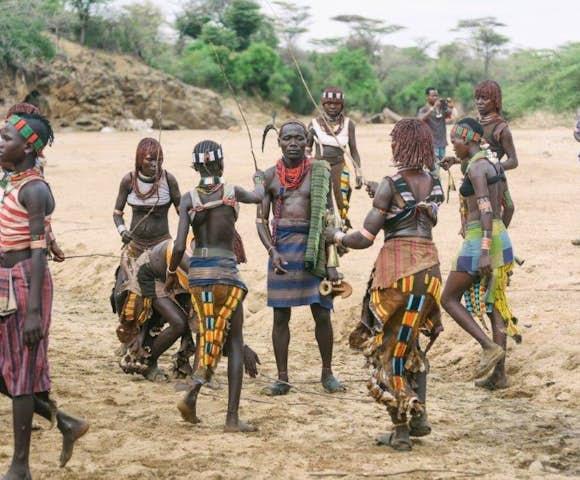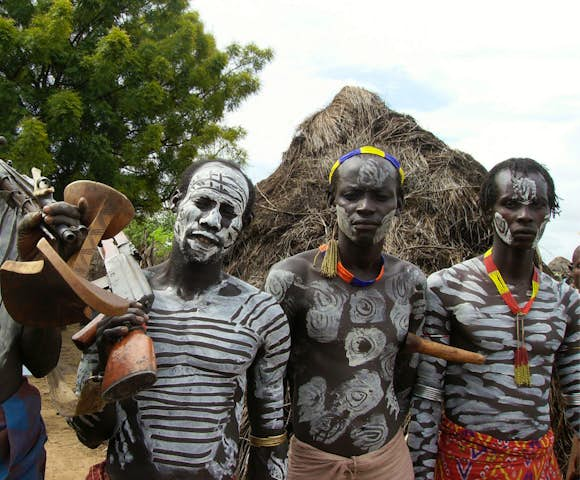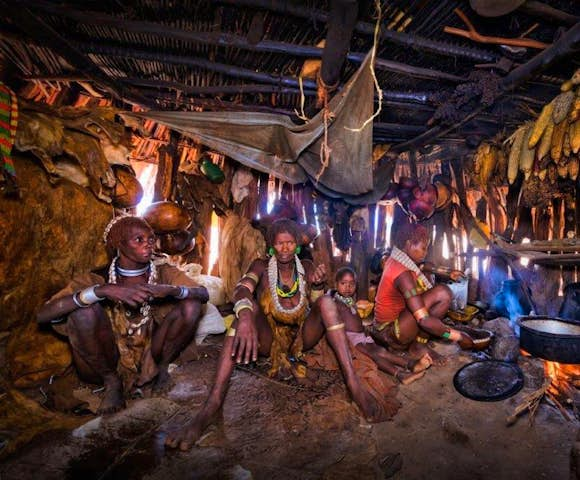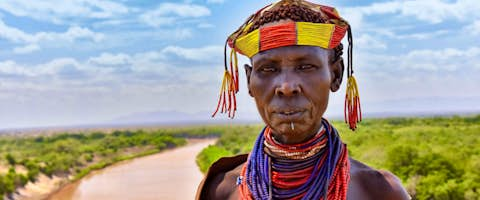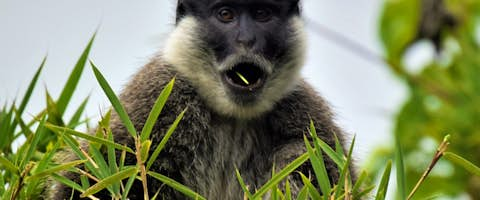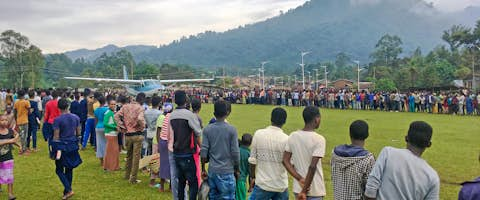Tribes of the Omo Valley
-
The Mursi
The Mursi are one of the better-known tribes of the Omo Valley, with a population of around 8,000. They are described as being a traditionally migratory community, although in reality they only move from the banks of the Omo in the dry season to the grasslands during the rainy season. The Mursi place considerable importance on cattle, the exchange of which marks most relationships, such as marriage, and their diets are also based around cattle.
They speak a Surmic language, which comes from the Nilo-Saharan language family. Their history is kept alive through a rich oral tradition of storytelling.
The most distinctive and recognisable feature of the Mursi women is wearing ornamental clay disks (debhinya) in their bottom lips as symbols of beauty and adulthood. When a girl is in her early teenage years, her bottom lip is cut and kept open with the clay disk until it heals. This cut is then progressively stretched over a series of months by inserting slightly larger clay disks each time, and each individual woman decides how far to stretch their lip.
Another feature of the Mursi tribe is their ceremonial duelling. This is where teams of men within the population fight with 2m wooden poles (donga), which only ends when one man either falls to the floor or has to retreat due to injury. These contests usually take place over several days and are treated extremely seriously. The women also have a duelling ceremony involving iron bracelets (ula) which they strike each other with. It is said that the ula is a symbol of strength, and only the strongest women are worthy of wearing it.
-
Bodi (Me’en)
The Bodi tribe are neighbours with the Mursi tribe, and the two groups frequently trade. They are pastoralist people who place a lot of importance on cattle and do not typically take part in cultivation practices, preferring instead to trade for maize and other agricultural products at tribal markets. They are nomadic communities, moving to prevent depletion of the land and to find new grazing areas for their cattle. Due to the importance of cattle in their lives, the main diet of the Bodi is also centred on cattle. In particular, they drink their milk mixed with their blood, which they obtain not by killing the animal by opening a wound in their neck.
Bodi men wear fabric skirts, whilst women wear clothes made from goat skin. Both men and women take part in the ritual of scarification, which is used to show the beauty and courage of individuals.
There is an incredibly unique tradition carried out by the Bodi people, called The Holiday of the Fat Men (Ka’el). This is where, each year, men are nominated by their families to take part in a competition whereby they spend six months putting on as much weight as possible by eating fatty food and stopping physical work. On the day of the ceremony each competing man covers himself with clay and ash before walking around a sacred tree, watched by all the members of their communities. Once the fattest man has been chosen a cow is slaughtered and the man is honoured with fame and hero status. In this tribe, fat is considered very attractive and so women also use this ceremony to look for potential husbands.
-
Suri
The Suri are a traditionally pastoral tribe on the west bank of the Omo River, with a culture centred around cattle. However, in recent times the Suri are relatively settled and also carry out agriculture and cultivation of grains. Cattle bring status to Suri people, and are a direct measure of a person’s wealth. Their tribe’s population is roughly 7,500 in total, with individual villages ranging from 40 to 2,500 people.
Each Suri household is run by a woman, who owns her own field and makes money from selling grains and beer. The Suri men are divided into different age-sets (children, young men, junior elders and senior elders) with each set having specific roles within the community.
Like the Mursi, the Suri people are known for stick fighting whereby unmarried men paint their bodies with chalk and fight with long, heavy poles, each man trying to knock the other down. Another similarity between these two tribes is the tradition of women stretching their lips and wearing large clay disks in the holes. Scarification is also practiced by both men and women.
Guns, particularly AK-47s smuggled across the border with Sudan, have found their way into the lives of the Suri people. Now it is considered the norm that all men must have a gun to be able to protect their family from enemies raiding their cattle or attacks from dangerous animals.
-
Hamar
The Hamar tribe live in an area east of the Omo River and have villages in Turmi and Dimeka. Their huts are made up of wood, straw, and mud with sloping roofs.
The Hamar people are best known for their ritual where women blow horns and shout taunts at male members of their family, who then whip them. The women allow themselves to be whipped until they bleed as a symbol of their devotion to the men. One of the most recognisable features of the Hamar women is their hair. They fix their hair in short, dense ringlets and mix in butterfat and red ochre to give it a characteristic dark red colour. Colourful bracelets are also worn around their waists and arms, in addition to shells adorning the edges of their goatskin dresses.
The men of the Hamar tribe are well known for their Bull Jumping ceremony. This is where a young man who wishes to marry must jump on top of a line of 10 to 30 bulls and run along their backs four times, completely nude and without falling, to prove their worth to the family of the woman they intend to marry. The entire ceremony can last up to three days. After this ceremony, the man is able to marry, own cattle, and have children. Following the bull jumping, members of the Hamar tribe will perform the Evangadi (night dancing) and enjoy a feast.
-
Daasanach
The Daasanach tribe are found in the most southern part of the Omo Valley and have a population of around 20,000. They live at the point where the Omo River delta enters Lake Turkana, in fact their name means ‘People of the Delta’. They are primarily pastoral people, growing maize, beans, and pumpkins at the time of year when the delta floods. During dry seasons they rely on their cattle and goats for milk, meat, and hides. Their homes are dome-shaped, made from branches covered with hides with mats covering the floor, and they have their own unique language.
The lower class of the tribe are called Dies, and are the people who have lost their cattle and hence their livelihoods. Rather than living with the rest of the tribe, they live near Lake Turkana and find food by fishing or hunting crocodiles.
The Daasanach have developed an extremely unique way of making jewellery from items such as SIM cards, old digital watches, and bottle caps. In fact, their headdresses made from bottle caps are particularly recognisable. Women wear pleated cow skin skirts with many bracelets and necklaces, whilst men wear a cloth around their waist.
-
Kara (Karo)
The Kara are a semi-nomadic tribe, and one of the smallest ethnic groups in the Omo Valley with a population between 1,000 and 3,000. They are found on the eastern shore of the Omo River and are related to the Hamar tribe. It is thought that previously the Kara and Hamar were part of the same tribe, which then separated in search for better lands. Due to this history, the Omotic language of the Kara people is linguistically very similar to that of the Hamar, and they share many cultural traditions.
The Kara were previously herdsmen who relied on cattle until a disease wiped out many of their herds, and they were forced to adapt to fishing and cultivation to survive. As a result, they developed agricultural techniques to grow corn, beans, and pumpkins, relying upon the flooding of the Omo River each year to replenish the soil with nutrients. They also have a unique fishing method, using long spears to pierce the fish. Only single young men can fish, and they must carry out a purification ritual afterwards because fishing was previously seen as taboo.
Their villages are made up of cone-shaped huts built by wooden poles weaved together and covered with mud, and roofs of straw. The huts have ‘doors’ constructed from wooden posts, where they hang objects such as buffalo ears or hooves as a symbolic entrance to the home. Clothing is simple, usually leather or fabric skirts, with more attention placed on bracelets and necklaces worn by both men and women. Also, hairstyles form an important part of the Kara culture, with men’s hair being braided, coloured, and decorated in elaborate styles with beads, feathers, and flowers.
Culturally, the most important ritual for the Kara tribe is that of bull jumping, which is very similar to the same tradition of the Hamar tribe to mark a boy reaching manhood. During ceremonies, the Kara paint their bodies with designs using white chalk, black coal, and yellow and red minerals. They also practice scarification, where the skin is deliberately cut to produce a raised scarring effect that is seen to have an aesthetic appeal for women, and signal achievements of men such as killing an enemy or a dangerous animal.
-
Banna
The Banna tribe are a semi-nomadic pastoral population of around 10,000 living near the Kenyan border. Their history is linked to that of the Hamar tribe as well, leading to a similar language and culture. Their livelihoods are centred around breeding cattle, sheep, and goats, and during the dry season they also collect and sell wild honey at local tribal markets.
Banna villages are set up with family huts built in a circle around the cattle in a central area. The huts are built with flexible poles folded inwards and drawn together to form a dome shape, covered in straw and cloth mats.
Like the Hamar and Kara people, the ceremony of bull jumping to mark a boy becoming a man and grant him the ability to marry and own cattle is incredibly important. They also perform rituals based around their traditional religion in which natural objects such as trees and rocks are inhabited by spirits.
As is the case for most tribes in the Omo Valley, clothing, styling, and body modification are an important part of the culture. Banna men colour and fix their hair with clay, which is then adorned with feathers, flowers, and beads. Girls have short, uncoloured hair until they marry, after which their hair is longer, braided and coloured with red clay.
-
Nyangatom (Bume)
There are two distinct groups within the Nyangatom tribe; the eastern group near the banks of the Omo River who have developed agricultural systems and permanent settlements, and the western group near the Kibish Basin who focus mainly on herding, although some cultivation is also carried out. The population of this tribe in total is roughly 7,000.
Both groups of the Nyangatom are related to the Topossa people in Sudan and their proximity to the Sudanese border has made it relatively easy for the Nyangatom to acquire arms, which are used as status symbols and in conflicts with neighbouring tribes. They celebrate the success of warriors with a ceremonial sacrifice of goats and the deliberate scarring of skin.
As with most Omo Valley tribes, clothing and ornamentation holds important cultural value. For women, social status is displayed in the number and colour of beaded necklaces they wear, with girls being given their first necklace by their fathers and then adding new ones every year, which are never taken off. Unmarried women wear goatskin skirts with bright beads, whilst married women’s skirts are less bright and not embroidered. For men, sharp metal rings and bracelets with filed edges are worn for use as defensive weapons, and scarring signifies their achievements as warriors.


